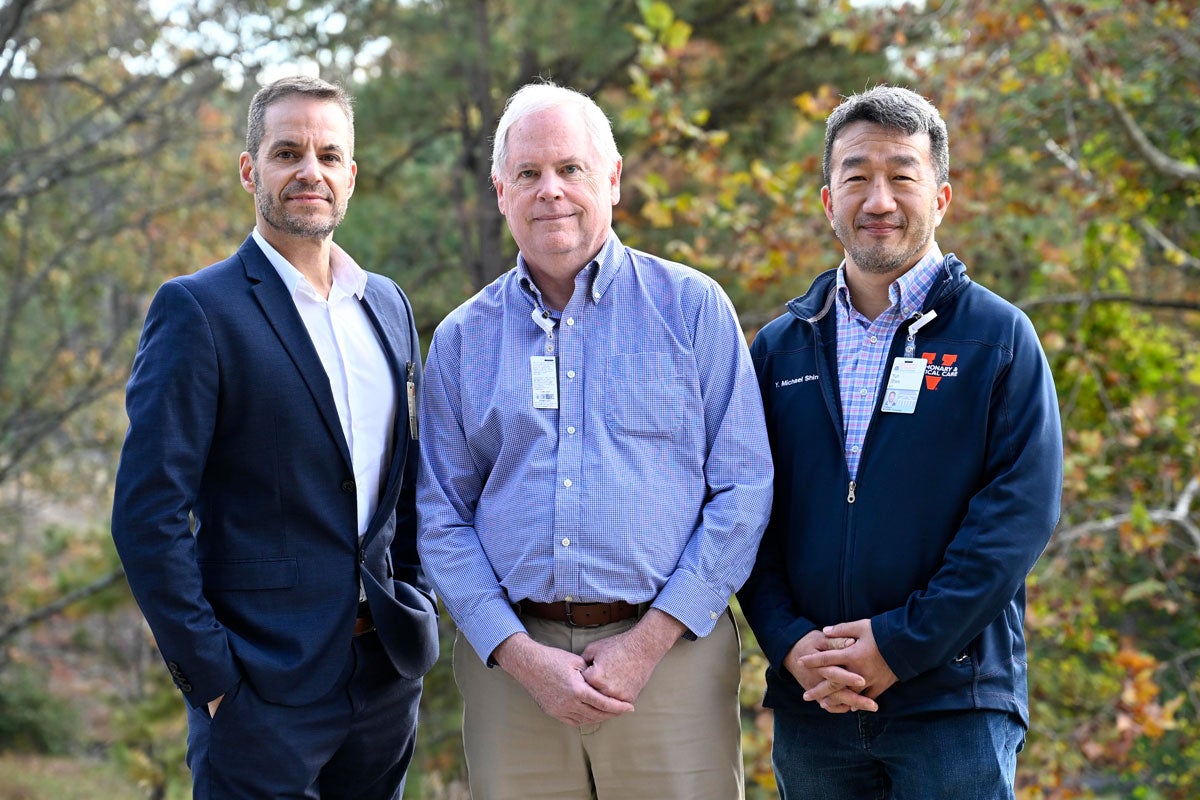
(From left) Jaime Mata, PhD, John P. Mugler, PhD, and Y. Michael Shim, MD
Three School of Medicine researchers, Jaime Mata, PhD, John P. Mugler, PhD, and Y. Michael Shim, MD, were awarded two, five-year NIH R01 grants totaling $7.4 million for research using hyperpolarized xenon-129 MRI to evaluate lung transplant rejection, and abnormalities in the lungs of electronic cigarette users. Drs. Mata and Mugler are professors in the Department of Radiology and Medical Imaging, and Dr. Shim is a professor in the Department of Medicine, Division of Pulmonary and Critical Care.
Drs. Mata and Shim and colleagues earned their NIH National Heart, Lung, and Blood Institute (NHLBI) $3.66 million grant for a project titled, “Developing Hyperpolarized Gas MRI Signatures to Detect and Manage Acute Cellular Rejection.” Drs. Mugler and Shim and team were awarded a $3.71 million NIH National Institute on Drug Abuse (NIDA) grant for their project titled, “Dissolved phase Hyperpolarized Xenon-129 MRI: A Novel Biomarker to Quantify Pulmonary Pathology in Young Healthy E-Cigarette Users.”
Hyperpolarized xenon-129 MR imaging is an emerging technology with which human lung physiology can be assessed with excellent spatial resolution, unlike other diagnostic modalities (chest CT, pulmonary function tests). The three multi-PIs are members of the Hyperpolarized Gas Research Group, which was formed at UVA over 25 years ago to translate UVA’s strength in MR physics and pulse sequence development into the clinical arena of pulmonary disease detection and characterization. This work is of significant interest because the UVA Hyperpolarized Gas Research Group acquired the world’s first MRI of a human lung using this technology in 1996, and since then has made numerous pioneering contributions to the field with applications including asthma, COPD and cystic fibrosis.
The MPIs of the two grant projects have developed novel technology that can detect early acute cellular rejection in lung transplant patients and pulmonary vascular pathology in young, healthy electronic cigarette users. Drs. Mata and Shim’s work has resulted in a new understanding of how lung transplant patients develop acute cellular rejection, and of the biomolecular mechanisms involved by using lung single-cell RNA sequencing. Their NIH-NHLBI R01 will validate these preliminary findings in 60 lung transplant patients evaluated longitudinally over 12 months with hyperpolarized xenon-129 MRI, chest CT, PFT, and bronchoscopy. Drs. Mugler and Shim’s work has resulted in the discovery that young, healthy e-cigarette users have abnormal pulmonary perfusion, which is speculated to cause abnormal cardiopulmonary function and potentially increased risk of lung injury in case of infection. Their NIH-NIDA R01 will validate these preliminary findings in 35 e-cigarette users and 35 healthy controls over 12 months with hyperpolarized xenon-129 MRI, chest CT, PFT, and cardiopulmonary exercise studies. These new grants blend their clinical and basic science expertise in medical imaging, pulmonary clinical research, and biomolecular research. This work will provide new insights into how hyperpolarized xenon-129 MRI can be applied to benefit patients.
Of note, UVA participated in the pivotal FDA Phase 3 trial for recent FDA approval of xenon-129 MRI and is now poised to implement this technology to be offered for patients in the near future. This work has been supported by many members of the UVA community, including a group of dedicated clinical research coordinators and other interested faculty members from adult and pediatric pulmonary, allergy, and thoracic surgery.
Additional collaborators on these grants include Hanna Mannem, MD (UVA Adult Pulmonary), Max Weder, MD (UVA Adult Pulmonary), Alan Ropp, MD (UVA Radiology), G. Wilson Miller, PhD (UVA Radiology), Yong Huang, MD, PhD (UVA Pulmonary), Nicolas Tustison, PhD (UVA Radiology), Ani Manichaikul, PhD (UVA Public Health Sciences), Arthur Weltman, PhD, (UVA Kinesiology and Medicine), Bastiaan Driehuys, PhD (Duke University), and Mikell Paige, PhD (George Mason University).
